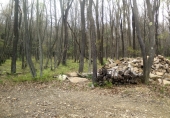TLDR: Had bad soil. Digging some up from the woods. Good idea? Bad idea? Share your thoughts.
Let me start by saying I did not know much about permaculture when we built our home (~2 years ago now). We built in the middle of the woods, which I love, and I took advice from friends / family / contractors who have owned or worked on land in this area on how to to do it. Part of that was clearing and removing absolutely all the topsoil around the house in a pretty large area. I wish I'd known to leave at least an area for my garden untouched, but I hadn't even planned where I'd put the garden at the time (we hadn't planned much : /). So last year when I put our garden in, this is the terrain I had to work with.

Not bad if you're just going to harrow it and plant grass (which we did for quite a bit of it) but rough start for a garden. By that time I was pretty convinced on the "no till" idea, and wanted to embrace it. "But I can't start with this" I thought. So I tilled it, and mounded up some raised rows thinking "I'll add compost every year, and this will be the only time I till". Our garden grew okay, with the exception of root vegetables (carrots, beets, onions... none fared well). But here I am this year, wanting to plant, and this is the state of those rows now.

Not the best picture, but you can see the dry cracked (rocky) ground. It's pretty much clay, and quite solid (I'm sure by my previous year's tilling helped it get this compacted). "I can't plant in this!" I said. And I I didn't want to til it again and compound the problem, so I began to spread everything organic I could find on top. Old hay, compost, grass clippings... But we don't actually produce enough "kitchen scrap" compost in a year to cover all the rows, and mulching is something I should have been doing all
last year... it doesn't give me much I can plant in
now.
So my next "great idea" was to try harvesting muck from one of the little streams that runs nearby. It's a fairly healthy stream, fed by a little spring on our neighbors farm, and the mud doesn't have any funky smell. I thought "surely this is full of good organic matter." Well.. it may be, but it's so wet that I still have the same structure issue. I added a bucket's worth of it to the end of one row, and here's how it looked the next day.

: / Something tells me that won't be great for planting either.
So there I was, wishing that we hadn't cleared away all the topsoil... when I realized that it was still there. Not where I was trying to build a garden... but right over there in the woods.

I headed into the forest with a rake, shovel, hoe and pitchfork and set to work seeing what I could find. I pulled away the turf with the hoe, and what I found...


Looked a heck of a lot more like garden soil than what was in my garden. So I started a repeating process of:
- strip away turf
- break up what I find with the hoe
- dig it out until I hit too much rock or clay (which happens pretty quickly... making this a slow process)
- take wheelbarrow loads over to my garden


So... this looks better anyway. At least it's something I can put seeds in, and seems like it will both have better drainage & better moisture retention than my clay... And hopefully comes with far more organic matter already incorporated. I'm hoping this gets me on track with a decent base, and that if I continue to mulch around veggies throughout the year, plant cover crops in the fall, and amend with compost in the spring, I can build up some nice soil over time.
Here's a picture of two rows worth of added "forest soil". (The darker one from just before the picture was taken. The lighter (dryer) from a day earlier.)

My concerns are:
- Am I wrong about the richness of the organic matter in this late-stage succession soil? Is it actually more "used up" than I've assumed?
- Am I going to get unwanted volunteers from this in the garden? (not that I don't anyway)
- This feels unsustainable... Not only is it a ton of work (this is so much later than I like to get most of my garden in...) but it gives the illusion of being "no input" (I just used what was here!) when actually the "input" is just from "over there in the woods", so I'm hoping this can be a "one time kick-start".
I may know more about permaculture than I did 2 years ago, but I still know very little. I'm reading/experimenting all I can, so I post to say "here's what I'm trying!" for your entertainment and would love any advice folks have to share.


















